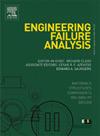水污染对锂基润滑脂性能故障的影响
IF 4.4
2区 工程技术
Q1 ENGINEERING, MECHANICAL
引用次数: 0
摘要
在潮湿的环境中,如矿井和海上风电场,润滑脂的性能会受到水污染的严重影响。本研究采用流变仪、球盘接触试验台、UMT摩擦磨损试验仪等一系列仪器和技术,评估了水污染对锂基润滑脂理化性能、流变性能、油膜厚度和摩擦学性能的影响。结果表明,2% 的含水量可以提高锂基润滑脂的抗剪切能力和极压能力。当含水量低于 4% 时,剪切粘度和结构恢复能力都会增加。然而,当含水量达到 8%时,润滑脂-水复合体系的平衡被打破,导致皂纤维表面形成断裂缺口,剪切粘度显著降低。此外,含水量为 2% 至 4% 的润滑脂能够形成较厚的多相混合润滑膜,其中皂纤维、基础油和水共存。相反,当含水量达到 6% 至 10% 时,油膜厚度会迅速减小。此外,油水混合物在边界润滑中的润滑油膜恢复能力不足。受水污染的润滑脂的摩擦系数会显著增加,在表面磨损严重的某个点,摩擦系数会达到初始完全润滑状态的 2-3 倍。这些发现为在潮湿环境中使用润滑油提供了技术支持,并突出了水污染对润滑油性能的潜在影响。本文章由计算机程序翻译,如有差异,请以英文原文为准。
The impact of water contamination on the performance failure of lithium grease
The performance of grease is significantly influenced by water contamination in humid environments, such as those found in mines and offshore wind farms. In this study, the impact of water contamination on the physicochemical properties, rheological properties, film thickness and tribological properties of lithium greases was evaluated using a series of instruments and techniques, including rheometer, ball-on-disc contact test rig, UMT tribometer and others. Results show that the water content of 2% can enhance both the shear resistance and the extreme pressure capacity of lithium-based grease. The shear viscosity and the structural recoverability increase when water content is below 4%. However, when the water content reaches 8%, the equilibrium of the grease-water composite system is disrupted, resulting in the formation of soap fiber surface breakage notches and a notable reduction in shear viscosity. Furthermore, grease with a water content of 2% to 4% is capable of forming a thicker multi-phase mixed lubrication film, wherein soap fibers, base oil and water coexist. Conversely, the film thickness is observed to diminish rapidly when the water content reaches 6% to 10%. Moreover, the oil–water mixture exhibits inadequate lubricating oil film recovery ability in boundary lubrication. The coefficient of friction of water-contaminated grease increases significantly, reaching 2–3 times that of the initial fully lubricated state at a certain point with severe surface wear. These findings provide technical support for the utilization of lubricants in humid environments and highlight the potential impact of water contamination on lubricant performance.
求助全文
通过发布文献求助,成功后即可免费获取论文全文。
去求助
来源期刊

Engineering Failure Analysis
工程技术-材料科学:表征与测试
CiteScore
7.70
自引率
20.00%
发文量
956
审稿时长
47 days
期刊介绍:
Engineering Failure Analysis publishes research papers describing the analysis of engineering failures and related studies.
Papers relating to the structure, properties and behaviour of engineering materials are encouraged, particularly those which also involve the detailed application of materials parameters to problems in engineering structures, components and design. In addition to the area of materials engineering, the interacting fields of mechanical, manufacturing, aeronautical, civil, chemical, corrosion and design engineering are considered relevant. Activity should be directed at analysing engineering failures and carrying out research to help reduce the incidences of failures and to extend the operating horizons of engineering materials.
Emphasis is placed on the mechanical properties of materials and their behaviour when influenced by structure, process and environment. Metallic, polymeric, ceramic and natural materials are all included and the application of these materials to real engineering situations should be emphasised. The use of a case-study based approach is also encouraged.
Engineering Failure Analysis provides essential reference material and critical feedback into the design process thereby contributing to the prevention of engineering failures in the future. All submissions will be subject to peer review from leading experts in the field.
 求助内容:
求助内容: 应助结果提醒方式:
应助结果提醒方式:


